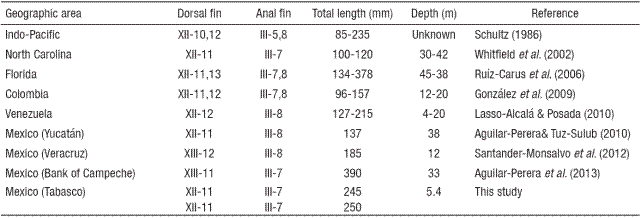The lionfish Pterois volitans (Linnaeus, 1758) is a native of the coral reef and coastal waters of the western Pacific from southern Japan to Micronesia, Australia, and the Philippines (Schultz, 1986). This species has been reported from the West Atlantic to the Caribbean Sea and Gulf of Mexico (Schofield, 2009).The invasion is assumed to have occurred through accidental or intentional release from aquaria (Whitfield et al., 2002).
The first Gulf of Mexico (GoM) report was from Florida in 2006 (Brown & Ruíz-Carus, 2006); subsequently, the species has been recorded in different areas of the Campeche Bank in the southern GoM (Alacranes Reef and Arenas Key) (Aguilar-Perera & Tuz-Sulub, 2010) and southwestern GoM (Anegada de Adentro, Veracruzano Reef System National Park and Tuxpan Coral Reef) off the state of Veracruz (Santander-Monsalvo et al., 2012). In this paper we document the presence of P. volitans in coastal waters of southern Tabasco.
Two specimens of lionfish were caught in San Pedro, Tabasco (18°39' 29.83" N, 92° 28' 52.49" W) on July 30, 2013 and July 10, 2014, using a trawl net with a mesh size of 2.54 cm in waters 5.4 m deep. The shoreline is a sandy beach followed by mangrove. Water temperature was 28 °C and salinity registered 34.5 PSU. The substrate was sandy clay. The specimens were transported to the laboratory where they were measured in total length (TL) to the nearest millimeter and weighed (TW) to the nearest gram. Their meristic characters were counted (number of fin-ray elements).The criteria used to identify the specimens were those described by Schultz (1986).
The lionfish caught had greatly elongated dorsal-fin spines. The membranes of all fins were mostly spotted. The body was white with reddish-brown vertical stripes. It had 11 dorsal-fin rays and 7 anal-fin rays. The red lionfish measured 245 and 250 mm in total length; their respective total weight was 152 and 160 g (Fig. 1). After examination and based on the diagnostic characteristics, we concluded that the specimens collected in Tabasco, Mexico are P. volitans. The specimens were deposited in the Ichthyology Collection of ECOSUR San Cristobal under catalog number ECOSC 7581and the Ichthyology and Aquatic Invertebrate Collection of the Centro de Investigación de Ciencias Ambientales of the Universidad Autónoma del Carmen under catalog number CI-CICA-UNACAR 0301.

Figure 1 Red lionfish, Pterois volitans (245 mm, TL), captured by trawl net with a mesh size of 2.54 cm in San Pedro, Tabasco (Mexico), Southern Gulf of Mexico. (Photo by Armando T. Wakida-Kusunoki). Barra = 5 cm.
A comparison with meristic data from populations along the Atlantic Coast of the U.S., the Gulf of Mexico, and the southwest Caribbean is presented in Table 1. The P. volitans caught off the Tabasco coast are larger in body size than the specimens from the Mexican Gulf of Mexico caught off the northern Yucatan Peninsula (Aguilar-Perera and Tuz-Sulub, 2010) or the Anegada de Adentro Coral Reef, off the coast of Veracruz (Santander-Monsalvo et al., 2012), and smaller than the record registered by Aguilar-Perera et al. (2013) in Arenas Key, Campeche Bank.
Table 1 Meristic data for Pterois volitans, from San Pedro, Tabasco (Mexico), Southern Gulf of Mexico compared to specimens from other geogra phic areas.

The potential negative impacts of lionfish on the native communities in the area include high depredation rates, competition, and overpopulation, the first being particularly alarming because of the significant reduction in forage fish recruitment (Côté & Maljković, 2010), bringing about changes in trophic relationships and disrupting the ecosystem. Besides threatening ecological function and biodiversity, the lionfish represents an economic and social risk; its diet not only includes a wide variety of smaller fish, shrimps and crabs (Muñoz et al., 2011), species of commercial value captured in small-scale fisheries in the south of Campeche and Tabasco, Mexico (Wakida-Kusunoki, 2005), but it also competes with snappers (Lutjanidae) and groupers (Serranidae) for food and habitat. Many native species are intensively fished, thus increasing the problem. The population of this exotic species should be appropriately controlled in order to protect native communities and rebuild the stocks of economically-important fish (Morris & Whitfield, 2009).
The lionfish captured in waters off Tabasco were located approximately 467 km away from the first record (La Pacharela, 58 km northeast of Alacranes Reef ) in 2009 by Aguilar-Perera and Tuz-Sulub (2010) and approximately 382 km from the second (Anegada de Adentro, Veracruz Coral Reef System National Park) in 2011 (Santander-Monsalvo et al., 2012).
The lionfish may have arrived in the area through dispersion by ocean currents (Hare & Whitfield, 2003). The lionfish can float and drift as larvae for a month to other areas (Johnston & Purkis, 2014). Conceivably, the larvae are carried by surface waters of the Yucatan current from the Yucatan-peninsula platform toward the Gulf of Mexico coastal region induced by winter winds (Martínez López & Pares Sierra, 1998). Wind direction and the Gulf's concave shape cause the Campeche Bank to have a clockwise wind-stress component throughout the year; a small region lying offshore from Campeche State has weak wind stress but fluctuates from a counterclockwise direction during spring-summer to a clockwise direction during autumn-winter (Zavala Hidalgo et al., 2003). This causes currents to converge at the southern end of the Gulf of Mexico, producing flows perpendicular to the coast, from the platform to the oceanic area. This may explain how the lionfish came to inhabit the area, an indication of this species's invasive progress in this area of the Gulf of Mexico.
We recommend further research and monitoring in particular of population density, predation of commercially-important species, and the presence, distribution, impact, and types of habitat that are especially susceptible to invasion by the lionfish (Morris & Whitfield, 2009).











 nueva página del texto (beta)
nueva página del texto (beta)


